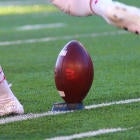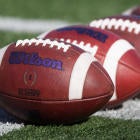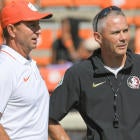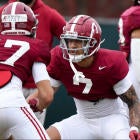Thanks to the Alliance of American Football, we now know what the game without kickoffs looks like.
The AAF debuted last weekend without toe meeting pigskin following scores. Offenses simply took over at the 25-yard line. No high-speed blocks, tackles or collisions. Definitely no injuries.
"It felt a little awkward," said Atlanta Legends coach Kevin Coyle, a veteran of more than 40 college and pro seasons. "For me personally, it felt strange not to kickoff and cover the kick."
Awkward, maybe, but safer.
Whether college football is headed in the AAF's direction is up for debate. But eight years into the rule-changing procedure to limit kickoffs, we do know the impact they have on players are at historical lows.
- For the first time since the NCAA began tracking such numbers, less than half of all kickoffs -- only 42 percent -- were returned last season.
- For at least the fifth straight year, touchbacks are up. The 2018 total of 4,273 was up almost 28 percent since 2013.
- The total number of kickoffs returned for touchdowns is down almost half from 72 in 2012 to 38 in 2018.
- Kickoff return yards are down 42.2 percent since 2011. That was the last season before the kickoff was moved from the 30 to the 35-yard line.
Now for the next step. Steve Shaw, secretary-editor of the NCAA rules committee, gave hope to traditionalists.
"Imagine Georgia-Florida and the place is up for grabs and we just jog out and put it on the ground," he said. "I think we want to do everything we can do to protect the play."
The NCAA remains in the process of a long-term injury analysis; in particular, it is studying head trauma. NCAA chief medical officer Brian Hainline told CBS Sports that the association is "taking a deep dive" into injury stats at the end of February.
He also said much of data "will be embargoed … but some may lead to policy change" regarding kickoffs.
However, Shaw said the injury rate is "significantly lower" simply with the increase in touchbacks.
"We're not on the verge of eliminating [the kickoff]," Shaw said. "We have a lot of things in the bag to make it safer. Three or four years from now, if it's not working out, it may be something we consider."
| 2013 | 2014 | 2015 | 2016 | 2017 | 2018 | |
|---|---|---|---|---|---|---|
Kickoffs returned | 60.5% | 58.4% | 57.3% | 55.1% | 54.2% | 42.3% |
Total touchbacks | 3,346 | 3,434 | 3,625 | 3,671 | 3,916 | 4,273 |
It was just last year that Texas coach Tom Herman told CBS Sports he expected kickoffs to be eliminated before he retired.
The numbers above were more or less expected. The college game has sought to reduce kickoff injuries in increments.
- For the first time last season, fair catches were allowed on kickoffs that landed inside the 25. That essentially created a 35-yard zone (including the end zone) that negated kickoff collisions. After one season of the new rule, 12 percent of kickoffs were fair caught in 2018. That's merely a starting point.
- The NCAA in 2012 followed the NFL in moving kickoffs up 5 yards to the 35-yard line, thus decreasing the likelihood of a return. From 2011-12, touchbacks -- with the ball spotted at the 20 instead of the 25 as a result -- immediately increased by 50 percent.
CBS Sports reported in July 2016 that preliminary discussions had begun into possibly removing kickoffs from the game.
The kickoff is simply not as important a play as it used to be. Since at least 2009, only three teams have returned less than 10 kicks in a season. All three came last year -- Middle Tennessee (four), UCLA and Eastern Michigan (nine each).
The idea of eliminating kickoffs started gaining strength in 2011. Rutgers player Eric LeGrand was paralyzed that year covering a kick. Former Rutgers coach Greg Schiano then proposed doing away with kickoffs.
The AAF adopted a portion of Schiano's proposal. Instead of an onside kick following a scorer, AAF teams have the option of taking the ball on their own 28 in a fourth-and-12 setting. If the offense does not covert, opponents take over with the ball deep in their territory.
That doesn't mean Brian Polian has to like any of it. Polian is Notre Dame's special teams coordinator. For 20 of his 22 years as a college coach, he has at least had a hand in overseeing special teams.
Referring to author Malcolm Gladwell's "Tipping Point," Polian proudly says, "My 10,000 hours [required for expertise] are in the kicking game."
"I don't like the college rule," explained Polian, a former member of the NCAA rules committee. "I don't like that a ball can be fair caught on the 4. Stanford had an exceptional kicker who could drop the ball anywhere with a 4.2-second hang time."
That day of a 38-17 Notre Dame win last season, Stanford kickoff specialist Jake Bailey, on average, placed his four kickoffs inside the Irish 2.
Because of Bailey, Stanford tied UAB for the national lead allowing only five kickoffs each to be returned all of last season.
"Five weeks after the Stanford game, it was, 'We ought to fair catch everything,'" Polian said, quoting ND coach Brian Kelly. "The truth is probably somewhere in the middle."
"There's gotta be some common sense answers to keep the kickoff. [Placing the ball at the] 25-yard line encourages that fair catch in college. It's taken an exciting play and turned it into [something less]."
Polian disagrees with his father on the subject. Bill Polian is the AAF commissioner and former NFL executive just elected to the Pro Football Hall of Fame.
"I was on NFL competition committee for 20 years," Bill Polian said. "We had a long discussion five, six, seven years ago when we began to look into safety issues and injuries. One of the people on the committee said, 'If we were reinventing football today, we wouldn't have the kickoff knowing what we know.'
"That really resonated with me."
The AAF had the advantage of creating a league from scratch with its own rules. College football is trying to reverse engineer one of the key parts of a 150-year-old game.
"It appears injury rates are down significantly," said Todd Berry, executive director of the American Football Coaches Association. "The intent we had was not only to try to minimize returns but to have the opportunity late in the game for individuals if they need [to return kicks] to have the opportunity to win."
It's been known for years that injuries occur at a disproportionately higher rates on kickoffs. That remains troubling when there are an average of only three kickoff returns per game, compared to an average of 140 plays from scrimmage per game.
Brian Polian isn't alone. Before last season, Stanford coach David Shaw told Tucson.com he wasn't "the biggest fan" of the new fair catch kickoff rule.
"Field position is the basis of the game," Shaw said. "To fair catch a ball and automatically move the ball up is difficult for me to take."
It's hard to argue safety, though. The NFL said last month concussions were down 29 percent compared to the 2017 season. Coyle, that AAF coach, was an analyst last season at LSU. The Tigers allowed only six of 79 kickoffs to be returned.
"We could probably play the game without it, and I don't think it has a tremendous impact," Coyle said. "I think we're probably heading in that direction."
The XFL is launching in 2020 and has already promised its own version of a safer game. Commissioner Oliver Luck told CBS Sports that the XFL wants "to keep the kickoff return in the game." However, the league is working on a kickoff hybrid that is, at the moment, a secret.
"Going to a game every week with the Colts, it's rare to see a kickoff return," Luck said, referring to watching his son, Indianapolis quarterback Andrew Luck, play. "To the point, I said to my wife, 'Somebody is going to break one of these [for a touchdown]. No one practices these anymore.'
"It's one of the great plays in football. But before we exile it to the trash heap, we've given it a lot of thought. We think we might have a solution."





















